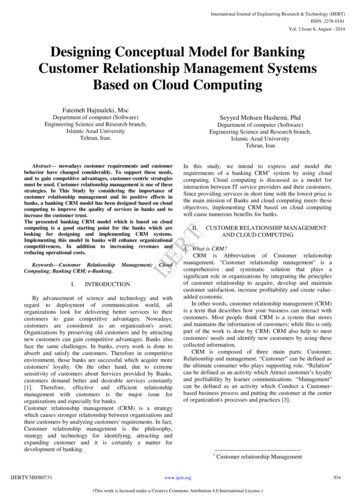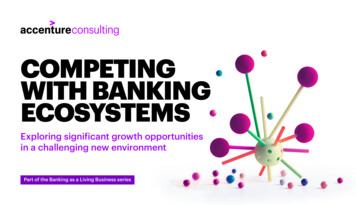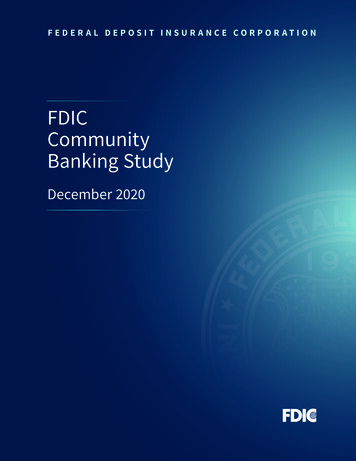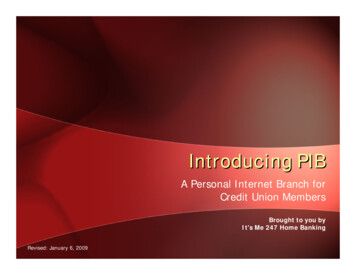
Transcription
BAI Banking StrategiesExecutive ReportMAY 2021COVID-19 isremaking customerservice forever
LETTER FROM THE EDITORCONTENTS32020: The year that changedcustomer serviceIn branches, apps and call centers, financialservices providers learned lessons thatthey will apply in the years ahead.Finding the human-digitalbalance in customer serviceBY TERRY BADGER, CFAtbadger@bai.orgA one-way trip to the future6912COVID-19’s shock to bankingforced digital conversions, and nowthere’s likely no going back.Humanizing customerservice post-COVID1821As powerful and versatile as these new digital tools are, they fall short in providing the humanconnection that so many customers want. Terri Panhans from Harland Clarke writes that empathy should be at the center of the customer-service experience because it’s good business.Even in ordinary times, customer service is a continual work in progress. But at this moment inbanking’s history, a key question is emerging: How much of what was done out of necessity willbecome standard practice after the pandemic has passed?She references a recent BAI Banking Strategies podcast in which my guest, Anson Vuong fromGallup, points out that customers who are emotionally attached to your brand are far more likelyto sign up for new services, seek financial advice and increase their balances.Whatever the road ahead looks like,lead with empathy and you’ll turn yourbanking clients into advocates.The trend in customer service has been moving toward digital self-service for years, and this accelerated during COVID. But there are situations when people want to interact face-to-face. BAIresearch during the pandemic shows that despite digital’s ascendance, customers opening an account or taking out a loan still prefer to do so in person.A banking revamp starts from withinWhere banks and credit unions are now and what’s to come is the theme for this BAI Executive Report.Fragmentation, manual processes andpiecemeal digitalization stand between yourorganization and a better customer experience.Our lead story by contributing writer Katie Kuehner-Hebert covers some of the most valuablelessons financial services providers have learned over the past year and how they are putting thatnewfound knowledge to work.Banks look to high-end hotels andother customer service superstarsto create a competitive edge.One of the key takeaways in her article is that proactively encouraging digital adoption can resultin a meaningful payoff for institutions. She shares the example of one community bank that, inreaching out to its customers, discovered many of them needed bank employees to teach themhow to use the digital tools. It’s time well spent, since moving more routine tasks to digital frees uppersonnel to handle more complex issues.Customer experiences thatsmile from ear to earFinancial services providers also offered new conveniences during the pandemic, such as curbsideservices and night drops for business customers. Some institutions plan to continue to make theseservices available as a differentiator, or hold them in reserve in case of future need.Puttin’ on the Ritz15By instantly upending the way they carried out their daily business, the COVID-19 pandemicforced banks and credit unions to focus on the fundamentals—and nothing is more fundamentalthan taking care of the customer.Truly listening to your customers canturn consumers into devotees. Use thesethree tips to inspire your biggest fans.Stop fraudsters from climbingyour phone treeAuthenticating callers before they hear“hello” can halt scammers snoopinginto your IVR systems.If any one thing seems certain, it’s that banking customer service will not fully revert to what it waspre-pandemic. Contributing writer Lauri Giesen notes that reopened branch lobbies are not seeing traffic levels comparable to what they were before March 2020, another sign of technology’ssizable impact.But, she writes, more customers going digital means customer service employees will have to develop expertise in the technology in order to field questions and troubleshoot problems. Theseworkers will also have to gain skills in using new technologies, such as video conferencing, toeffectively work with customers.Even when that emotional connection and trust are established, customer service succeeds byhelping the customer with their needs. To that end, Greg Kanevski from ServiceNow writes thatfinancial services providers should be working to create end-to-end digitalization that benefitsboth consumers and employees.The good news, he says, is that “for the financial services industry to thrive, no one has to startover. The key is to fix the broken connections between existing systems and processes.”Other articles in this month’s Executive Report include:» BAI contributing writer Edmund Lawler examines how some financial services providers are looking at the practices in other industries—from high-end hotels to fast-foodchains—to pick up insights on how to upgrade their customer service, inspire greaterloyalty and lock in lifetime value.» Jessica Stallings from LogMeIn offers three powerful tips to inspire your customers tobecome your biggest public boosters. It starts with showing those future brand ambassadors just how much you value them» And Neustar’s Adam Russell addresses contact center fraud with advice on how to stopbad guys before they even speak to an agent. The fraudsters’ schemes and technologygrow more sophisticated all the time, so there’s value in authenticating callers beforethey reach your interactive voice response system.Striking the right balance between people and technology is the name of the game in customerservice. Those able to do it most effectively and most efficiently stand to gain a competitive edgein financial services, in 2021 and beyond.Terry Badger, CFA, is the managing editor at BAI.
2020: The yearthat changedcustomer serviceBY KATIE KUEHNER-HEBERTIn branches, apps and call centers,financial services providerslearned lessons that they willapply in the years ahead.
’’We understoodthat peopleneeded to feelwelcomed, safe,respected andserved.THURBER TRACYPLUMAS BANKs the world begins to emerge from theCOVID-19 pandemic, financial institutionsare learning that the feedback customers provided during the crisis will echothroughout customer-service initiatives in the industry for years to come.Adited the launch of Regions Bank’s latest mobile app,says Brandi Miller, senior vice president, voice of thecustomer—digital banking at the 146 billion bank inBirmingham, Alabama.We gathered bankers and industry experts to sharetheir perspective on what existing capabilities workedwell, what needed enhancement and what lessonsthey learned that can further boost customer servicein the post-pandemic “new normal.”“More check deposits and money movement were occurring in mobile than ever before,” Miller says. “Wefocused on improvements to this functionality, likelimit increases and the ability to view check images inour app. We plan on adding more capabilities, such asthe availability of account statements on the app andthe ability to live chat from mobile.”president, administrative services manager. Employees sent handwritten notes letting clients know howmuch they missed them, while also providing a list ofways to bank without coming into the branch.Staff also held virtual meetings with businesscustomers and offered curbside and night dropservices at the branches, Tracy says. Post-pandemic,such services may continue to be available for special circumstances.When Plumas’ branches reopened, staff focused on“putting smiles of reassurance in our voices underneath the masks, and clients seemed to feel more atease,” she says. “We understood that people neededto feel welcomed, safe, respected and served.”Consulting in New York City. But there was a catch-22:Should they implement RDC now or continue to buildrelationships in the branch post-pandemic?“A number of customers did move to larger banks because a lot of the mid-size and smaller banks lackeddigital infrastructure,” Walker says. “As a result, manysmaller banks chose to speed up their digital transformation that, in some cases, was already underway.Further, some developed hybrid models of personalcontact and digital service.”BRANCH OPERATIONSDIGITAL CHANNELSBanks learned during the pandemic that focusingon customer experience would maximize their ongoing digital transformation efforts, says GrahamTasman, principal, risk advisory service leader andbanking sector lead at Chicago-based advisory firmGrant Thornton.Indeed, customers giving feedback on what theyneeded most during the pandemic shutdowns expe-4 MAY 2021Many Wells Fargo customers used the bank’s mobileapp for the first time during the shutdowns, says MaryMack, CEO of consumer and small business banking at the 1.8 trillion bank based in San Francisco.More customers are also now utilizing mobile walletsand contactless payments.Many community and mid-size banks accelerated theadoption of technologies like remote deposit capture(RDC), says Richard Walker, a principal with DeloitteWhen the country shut down, banks had minimal timeto deal with much beyond ensuring reliable networkaccess so their employees could effectively workremotely, Tasman says. “On that first trial they responded surprisingly well.”At the 1.1 billion Plumas Bank in Quincy, California,branch employees working remotely “were remarkably creative in how they reached out to their clientswith poise and compassion,” says Thurber Tracy, viceBANKINGSTRATEGIES.COM
’’Most importantly,banks learnedthat customerswanted empathyand support—theydidn’t want to besold to.CHRIS ACEVEDOGRANT THORNTONAs more customers utilized online banking for simpletransactions, Plumas’ branch staff focused on helping customers with more complex financial needs,including helping business owners secure PaycheckProtection Program loans.To enable social distancing, Regions’ branchespredominately used drive-through lanes and appointment-only meetings with branch staff, remindingcustomers about scheduling capabilities on themobile app. Customer feedback provided through surveys and social media was positive.Wells Fargo developed an in-house digital waitlistsolution for select branch locations, to better managethe number of customers inside.“Customers without a confirmed appointment reservea place in line with the digital waitlist,” Mack says.“When it is the customer’s turn to meet with a telleror a banker, employees used the system to send a textmessage to the customer's mobile device.”5 MAY 2021Branch employees working remotely were also redeployed to help with mortgage forbearance initiativesand collection programs, Walker says. Post-pandemic, additional activities like these might be a way toprovide consistent work for branch employees duringslow periods, and cross-training them for other functions might reduce branch turnover.CONTACT CENTERSRegions provides an online AI chatbot that connectscustomers to a contact center agent if the chatbotcan’t immediately answer their questions. Thanks tocustomer feedback during the pandemic, the bank isnow looking to expand the AI chatbot functionality toits mobile app.For banks with contact centers in different geographies to enable 24/7 servicing, the pandemic exposedvulnerabilities, says Joanna Chai, Grant Thornton’smanaging director, strategies and transactions.“During this pandemic, some of those locations thatrequired close proximity to fellow contact centerstaff became unworkable,” Chai says. “Many bankswere resourceful and leveraged branch employeesand staff in other business lines to provide contactcenter support remotely. Banks now realize theyneed to be better prepared if something like thisever happens again.”One community bank proactively called its customers,and it learned that many customers needed employees to walk them through how to use the digitaltools, says Chris Acevedo, Grant Thornton, managingdirector for financial services. The pandemic also accelerated the trend of branch and other staff helpingcustomers in a video format.As more people used contact centers and digitalchannels during the shutdowns, J.D. Power customersatisfaction rates initially went down, Acevedo says.“Banks were exposed to what worked and whatthey needed to lean into more,” he says. “Mostimportantly, banks learned that customers wantedempathy and support—they didn’t want to be soldto.” More banks are now leveraging data visualizationand performance analytics “to design more effectivecustomer journeys.”Wells Fargo learned from the first round of PPP loansthat many small businesses that needed help hadnot applied. The bank conducted a targeted emailoutreach to more than 500,000 of its small businesscustomers located in low-to-moderate income or ma-jority-minority census tracts, to raise awareness andprovide tools to better understand the PPP program.Banks have learned many things about their customerservice levels during the pandemic that they can nowleverage to enhance experiences as everyone adopts tothe “new normal.”Katie Kuehner-Hebert is a contributing writer to BAIBanking Strategies based in Running Springs, California.She has more than three decades of experiencewriting about the financial services industry.BANKINGSTRATEGIES.COM
A one-waytrip to thefutureBY LAURI GIESENCOVID-19’s shock tobanking forced digitalconversions, and now there’slikely no going back.
s the financial services provider to employees of more than 80 different companies,BCU has had physical branches in theoffices of more than 10 of those corporations—including big companies like GEICO, Targetand UnitedHealth Group.ASo when the pandemic struck last year, the VernonHills, Illinois-based credit union had to shut down mostof those in-office branches and find a way to not onlyserve members who were now working from home, butalso get its own employees set up to provide servicewhile working remotely.“Our strategy was to make sure our members could getthe same services as they could get in person,” saysDaniel Parsons, BCU vice president, branch operations.At the same time BCU was moving its services out ofcorporate centers and into an online mode, it was dealing with two other trends: the accelerated use of digitalservices and a rush of mortgage applications, the latterdue to low interest rates and increased real estate sales.Even though many branches have reopened and somemembers are back working in their offices, BCU doesn’tthink it will ever fully return to the way things used to’’As banks reopenedtheir branches, thefull bounce backnever came ascustomers founddifferent ways tointeract with theirbank.TOM MCDERMOTTINVER CONSULTING GROUPbe. Members have learned new ways of conductingtheir financial business, and many will want to continuein that direction.“Our focus has always been to meet members wherethey want to meet,” Parsons says. But where that placeis located is changing. He expects branches will serveas the “hub” of customer service, but much interactionwill take place outside of them. That may be in members’ homes or it may be in a local coffee shop.7 MAY 2021And BCU is not the only financial institution thatexpects the pandemic will change how it services customers in the future.“The pandemic changed people’s relationship withservice providers, not just in banking, but in how theyrelate to other providers and retailers,” says CathyCooper, executive vice president of retail banking forSeattle-based Washington Federal.“Branch transactions dropped by between 25 percentand 50 percent at most banks during the pandemic,”says Tom McDermott, co-founder of Atlanta-basedInver Consulting Group.As consumers during the pandemic accelerated theiruse of technology to shop, communicate with familyand even go to church, that digital fluency is likely toextend into banking, Cooper says.“And as banks reopened their branches, the full bounceback never came as customers found different ways tointeract with their banks.”Washington Federal either shut down many of itsbranch lobbies during the height of the pandemic oroffered limited in-person services. Many call center em-BANKINGSTRATEGIES.COM
ployees also served customers remotely. “Luckily, wedecided in 2019 to give laptops to most of our staff, soit was easier for them to transition into working fromhome,” Cooper says.At Columbia, South Carolina-based SouthState Bank, 95percent of customer care representatives were workingremotely at the height of the pandemic, according toJohn McCutchen, senior vice president of customercare operations. Some of those representatives havesince moved back to bank centers, but some still remain working from home.All of the customer care employees have seen a significant increase in volume, as customers who might havegone into the branch before turned to the call center.SouthState Bank began reopening lobbies with modi-’’Many of ourcustomers trieddigital services forthe first time duringthe pandemic.MARTHA REABOLDSOUTHSTATE BANKfied hours last fall, but did not return to full in-personservice until March 2021.BCU, Washington Federal and SouthState all saw theuse of mobile services, especially mobile check deposit,accelerate dramatically, and that created new customer-care challenges. “Many of our customers tried digitalservices for the first time during the pandemic. Theymay have been resistant to them before, but when theyneeded to learn how to use them, they found out howeasy it was and found them to be very convenient,”says Martha Reabold, director of consumer banking forSouthState Bank.Washington Federal saw a 30 percent increase inmobile deposits alone. SouthState saw a 30 percentincrease in all digital transactions over the year.But having more customers using mobile servicesrequires call center employees to adopt new skills. It isthese employees who often have to teach customershow to use digital devices and answer customer questions. That means call center representatives oftenneed additional training in how the services work andwhat problems might arise.8 MAY 2021“Our customer care employees are the first point ofcontact our customers have when they have questions about digital services. Our employees have tobe very skilled to answer their questions,” McCutchensays. Only when the question is very technical or thereare connectivity issues are customers passed on to adigital services team.seen and allows screen sharing so that representativescan better explain services and options.Some financial institutions also experienced an increased demand for videoconferencing for customerservice as well as for sales, another new service adopted because of the pandemic. BCU is using a proprietaryvideo service that allows customers to see the servicerepresentative but keeps the customer’s image private.Parsons says the service is great for demonstratinghow various products and services work by walkingcustomers through the process online. Videoconferencing can also provide homebuying education andloan information to mortgage customers, he says.But as customers get used to these new ways of interacting with their banks, will they go back to the oldway? Probably not, say many experts.Washington Federal expects to debut a videoconferencing service in June that utilizes Microsoft Teams.That service will let customers decide if they want to beCooper also expects more customers will make appointments to discuss financial issues with advisersin the branches, rather than just show up and hope anadvisor is available.“A lot of good lessons were learned during the pandemic and that is going to affect how banks service theircustomers beyond 2021,” says McDermott.Lauri Giesen has spent more than 25 years writing aboutbanking technology and payments for numerousbusiness and financial publications. In the 1990s, shefounded and edited Financial Service Online, a magazinecovering Internet-based forays into banking andinvestment services.BANKINGSTRATEGIES.COM
PLUMAS BANK A s the world begins to emerge from the COVID-19 pandemic, financial institutions are learning that the feedback custom-ers provided during the crisis will echo throughout customer-service initiatives in the indus-try for years t










